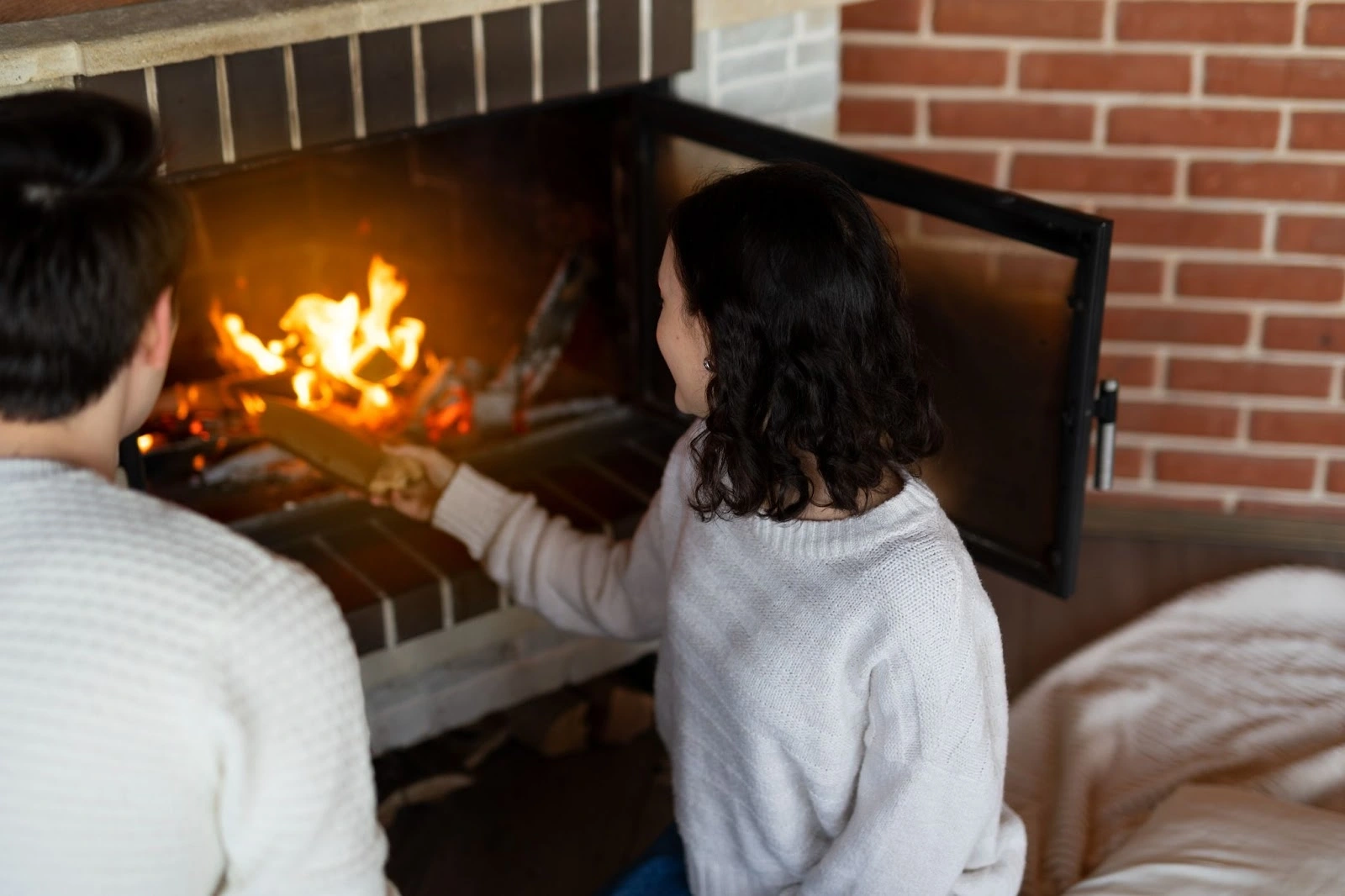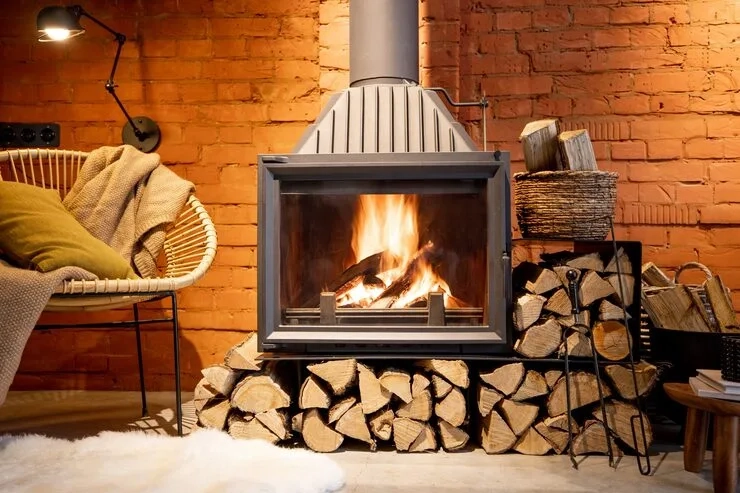Ensure your fireplace is clean, safe, and ready to warm your Texas home all winter.
A crackling fire on a cool Texas evening is one of life’s simple pleasures. However, before you get to enjoy that cozy ambiance, you need to make sure your fireplace is ready for the task. Skipping a few key steps can turn a source of comfort into a serious safety hazard. Taking the time to properly winterize a fireplace can help you get a good fire going and protect your family and your home. Preparing your hearth doesn’t have to be complicated. With proper care and professional fireplace maintenance in Waco, you’ll be ready to enjoy cozy fires throughout the winter.
Table of Contents
ToggleDon’t Skip the Professional Chimney Sweep and Inspection
This is, without a doubt, the most critical step you can take to winterize fireplace. Think of it like getting the oil changed in your car. It’s an essential maintenance task that prevents a much bigger, more dangerous problem down the road. The main reason for this is creosote, a highly flammable dark, tar-like buildup.
A chimney sweep will conduct a thorough inspection, which typically falls into one of three levels as outlined by the Chimney Safety Institute of America:
- Level 1 Inspection: This is a basic visual check. The technician looks at the accessible portions of your chimney and fireplace from the outside and the inside to make sure the structure is sound and there are no obvious blockages. It’s the standard for an annual inspection when you haven’t made any changes to your fireplace system.
- Level 2 Inspection: This is a more detailed, in-depth inspection, often required when you’ve made a change to your system like replacing a firebox or installing a new flue liner. This inspection involves using a camera to check the inside of the flue for hidden damage or creosote buildup that isn’t visible from the outside.
- Level 3 Inspection: This is the most comprehensive and is only done when a Level 1 or 2 inspection identifies a serious issue. It may involve removing parts of the chimney structure to get a closer look at a critical problem.
A professional sweep has the right tools and expertise to safely remove creosote and other debris like bird nests, leaves, or even dead animals. They can spot hairline cracks in your flue liner that could allow hot gases to escape into the walls of your home and ignite combustible materials. A good sweep is a small investment that offers a massive return in peace of mind and fire prevention.
Check and Understand Your Damper
The damper plays a crucial role in how your fireplace functions. Acting like a seal, it controls airflow through the chimney. When a fire is burning, it must be fully open to allow smoke and dangerous carbon monoxide to escape safely up the chimney. When the fire is out, it must be closed to prevent cold outdoor air from rushing in and conditioned indoor air from escaping, which is a big deal for your heating bill.
There are two main types of dampers.
- Throat Damper: This is the traditional type you’ll find in most older homes. In many traditional fireplaces, you’ll find the damper positioned in the lower section of the chimney, right above where the fire burns. It’s typically made of heavy metal and serves as the first barrier controlling the flow of air and smoke. While they do a decent job, they are often not perfectly airtight. They can also rust over time, making them difficult to open and close, or preventing them from sealing completely.
- Top-Sealing Damper: This is a much more modern and efficient option. It’s installed at the very top of the chimney, creating a tight, rubber-like seal that prevents air from escaping or entering your home. These are operated by a cable that runs down the chimney and is mounted inside the firebox. Top-sealing dampers are incredibly effective at improving your home’s energy efficiency by stopping heat loss in the winter and preventing hot, humid air from coming in during the summer.
No matter which type you have, test your damper to make sure it moves freely and creates a good seal. If it’s stuck, rusty, or won’t close all the way, it’s time to call a professional for a repair or replacement.
Inspect the Firebox and Hearth for Damage
The firebox is the heart of your fireplace – the brick-and-mortar space where the fire burns. Over time, the extreme heat can cause the materials to degrade. Take a close look at the firebrick and the mortar joints.
- Cracked or Spalled Bricks: Spalling is when the surface of a brick peels or crumbles away. This is a sign of moisture damage or intense heat stress. A few small hairline cracks are usually nothing to worry about, but larger, deeper cracks or crumbling bricks can be a sign that the structural integrity of your firebox is compromised.
- Deteriorating Mortar Joints: The mortar between the bricks can crack and fall out. If this happens, hot embers or flames could potentially escape through the gaps and into the combustible wood framing of your home. It’s a very serious fire hazard.
The hearth is there to catch any sparks or embers that might pop out of the fire. It should be made of brick, stone, tile, or another fire-resistant material and be free of any cracks that could trap embers.
Ensure Proper Airflow (Draft)
A good chimney draft is what pulls the smoke up and out of your house. If smoke is spilling back into the room instead of rising up the chimney, it’s often due to poor airflow. In many cases, something is obstructing the flue, which is why routine inspections and cleanings by a qualified chimney sweep are essential. However, the problem is sometimes caused by something else:
- Negative Pressure: Your home is a sealed system. If you have an exhaust fan running or a dryer going, it can create negative pressure that pulls air down the chimney instead of letting it go up.
- Improperly Sized Flue: If your chimney flue is too big or too small for your firebox, it can disrupt the airflow and prevent a proper draft.
- Cold Air: A cold chimney pipe can make it harder to get a draft started. You can solve this by rolling up a few sheets of newspaper, lighting them, and holding them in the flue for a few seconds to “prime” the chimney with warm air.
Making sure your airflow is right is crucial for both comfort and safety. A strong draft means all the smoke, ash, and dangerous gases like carbon monoxide are safely vented outside.
Get Your Supplies Ready
The type of wood you burn makes a huge difference in the fire’s quality and safety.
- Properly Dried Wood is Essential: The golden rule of wood burning is to use only seasoned firewood. This is wood that has been cut and left to dry for at least six to twelve months. It should have a moisture content of 20% or less. You can tell if wood is seasoned if it’s lighter, has cracks at the ends, and makes a hollow sound when two pieces are hit together.
- Why Seasoned Wood Matters: Green (unseasoned) wood is full of moisture. Burning it is inefficient because a lot of the fire’s energy goes into boiling off the water. This creates excessive smoke and more creosote. Using seasoned logs means a hotter flame, a cleaner burn, and reduced creosote in your chimney.
- Choose the Right Wood: Hardwoods like oak, pecan, hickory, and maple are excellent choices because they burn hotter and longer. Avoid softwoods like pine and spruce, which contain a lot of sap and tend to build up more creosote.
A long-handled poker helps you safely adjust logs, tongs allow you to reposition burning wood, and a shovel and brush are essential for cleanup. Don’t forget a metal ash bucket with a lid as this is the only safe way to store hot ashes.

Safely Clean Up Last Season’s Mess
Before you light a new fire, it’s good practice to clear out the old ashes. While a thin layer of ash can actually help insulate the next fire, a thick buildup can restrict airflow and create a mess. However, be extremely careful. Ashes can contain hot embers for up to four days after a fire.
- Metal Bucket: For safe cleanup, scoop ashes into a sturdy metal bucket with a tight-fitting lid. Avoid plastic or cardboard, which can easily ignite.
- Take It Outside: After scooping the ashes into a metal bucket with a tight-fitting lid, take it outside and place it on a non-combustible surface like concrete or stone.
- Wait: Let the ashes cool completely for several days before you dispose of them in your regular trash.
Consider a Fireplace Screen or Glass Doors
With the groundwork complete, all that’s left is to add a final shield.
- Fireplace Screens: A simple, decorative screen is a great way to prevent sparks and embers from popping out onto your floor, pets, or children. It also helps contain some of the ash and debris that flies up from the fire. They are a necessary safety barrier, especially in a home with kids or pets.
- Glass Doors: Glass doors provide a more robust barrier against sparks and embers. Second, they can greatly improve your home’s energy efficiency. When the fire is out, closing the doors creates a seal that prevents air from escaping up the chimney, much like a top-sealing damper. This can save you a significant amount on your heating bill. Just remember that when the fire is burning, the doors should be open unless the manufacturer’s instructions state otherwise.
Preparing your fireplace for winter is a task that combines a little bit of home maintenance with a lot of peace of mind. By taking the time to address each of these key areas, you’re getting your home ready for the cold and actively preventing potential hazards. A clean, well-maintained fireplace is a safe one and that’s the most important step in making sure you can truly relax and enjoy the season.
Conclusion
If you’re wondering how to get fireplace ready for winter, the answer comes down to three things – cleanliness, safety, and the right preparation. So, as you get your fireplace ready to go, consider what you might need to make it safer and more efficient this year. A fresh set of fireplace tools, a new screen, or even a brand-new fireplace could be just the thing to elevate your cozy winter nights.
For high-quality fireplaces and accessories, visit Darden Building Materials.

